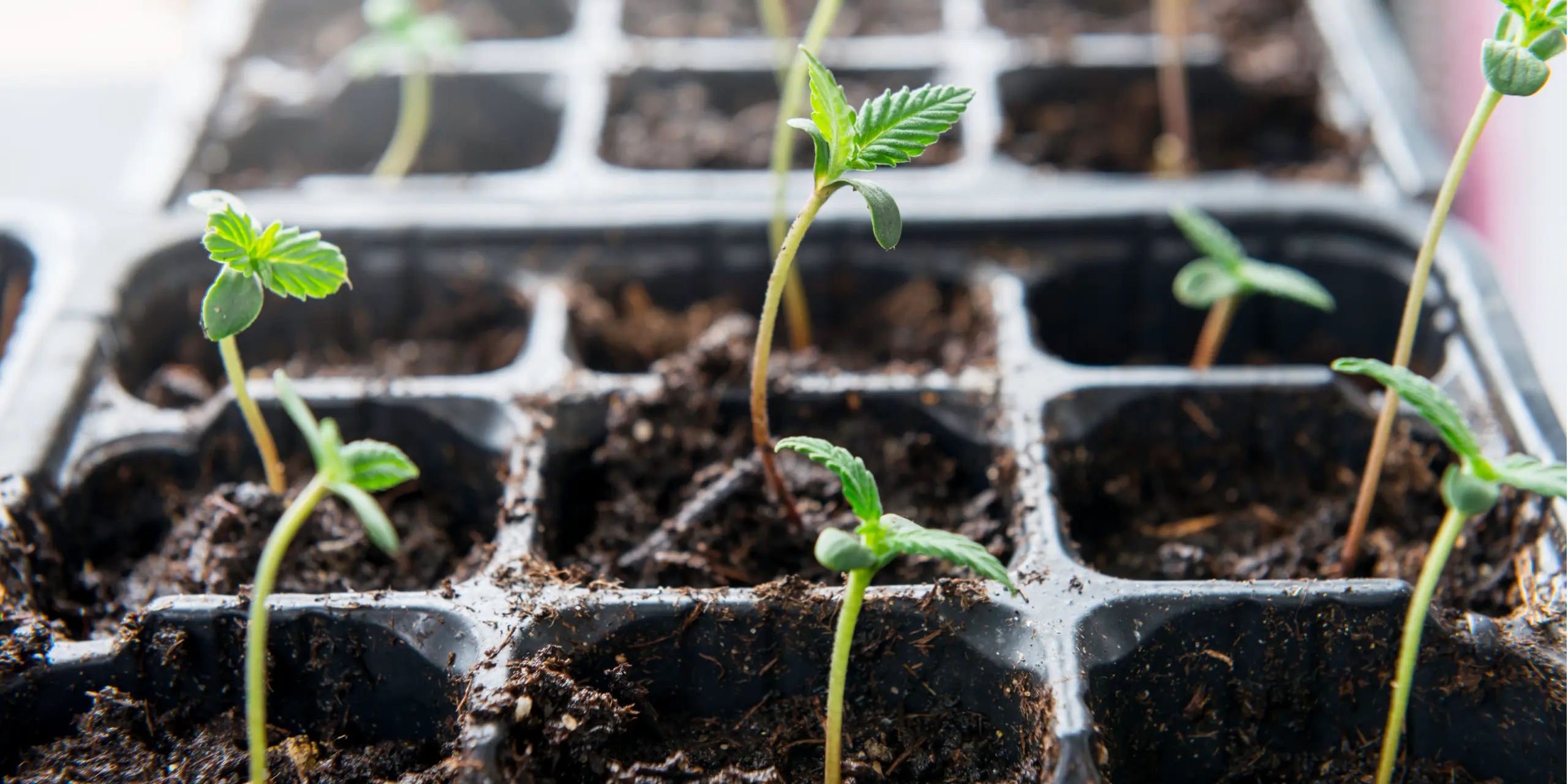Discover how to use a VPD chart to grow the best plants ever

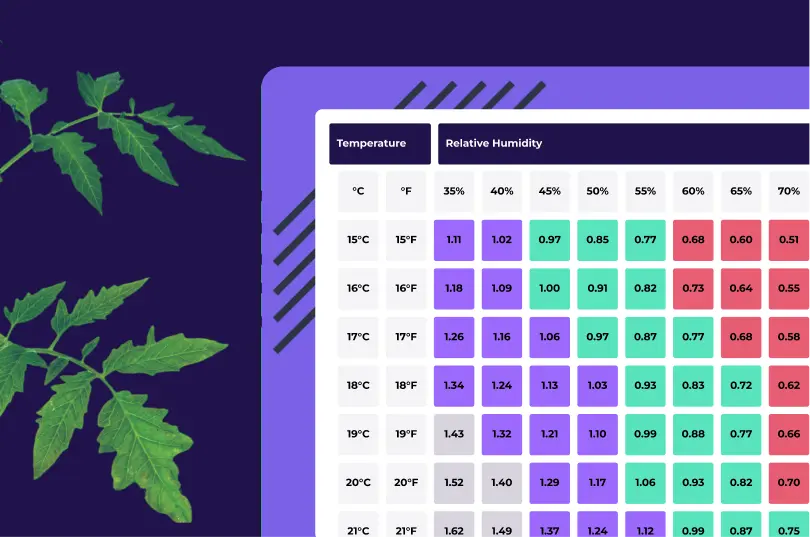
Understanding VPD
Understanding and mastering the Vapour Pressure Deficit (VPD) is a game changer for most indoor growers. This concept, often overlooked, is key to optimising plant growth, yield quality and quantity.
You don't want to rely on guesswork or bro-science, but there's a sea of information out there. If you already know a bit about VPD and would like a bit of a tune-up without the complex formulas and maths, you’re in the right place!
Read on for handy calculators, recommended VPD ranges, and user-friendly reference charts.
VPD, standing at the intersection of humidity and temperature, dictates how plants breathe and transpire. It's not just about providing the right amount of light or nutrients; VPD is the unseen force that can make or break a harvest.
At its core, VPD affects how plants absorb nutrients and water, impacting their overall health and potency.
This balance of environmental factors is crucial, especially in a controlled setting like indoor cultivation, where every variable counts.
Using VPD charts for cannabis isn't just about hitting numbers; it's about understanding your plants' language.
If you’ve experienced surprisingly slow growth, the sudden emergence of powdery mildew or other baffling problems, the good news is that by tweaking one key aspect - VPD, you can create an optimal environment that allows your plants to flourish!
VPD tells us what the plants need and when they need it, ensuring we provide the best conditions for each growth stage, from seedlings to flowering.

What you'll learn
We'll explore what a VPD chart is, how to read it, and why it's essential for your cannabis plants.
Whether you are a seasoned grower or just starting, understanding VPD charts is your first step towards a thriving, bountiful harvest.
Disclaimer: Any information given on this site is for educational purposes only. Please ensure if you’re growing cannabis, you’re doing so in accordance with the law and subject to appropriate permissions and licenses of the applicable country.

Understanding VPD in cannabis cultivation
Vapour Pressure Deficit VPD is a critical yet often misunderstood aspect of indoor cannabis cultivation.
At its simplest, VPD is the difference between how much moisture is in the air and the maximum amount of moisture it can hold when saturated (saturated vapour pressure).
This gap is crucial for understanding plant behaviours like transpiration, the process where plants release water vapour into the air.
When you grow cannabis indoors, VPD plays a pivotal role. It directly influences how plants transpire and breathe, affecting their ability to take up nutrients, CO2 and water.
Why is VPD important?
VPD is important because it allows you to work out the suitable range of temperatures and humidity to aim for. This allows you to optimise and fine-tune your grow room.
Maintaining the right temperature and relative humidity in your grow room has several benefits:
- It makes it possible for you to avoid environmental issues like mould and mildew.
- It allows you to evade pest problems.
VPD also affects:
- Stomata opening
- How fast your plants transpire (give off water vapour through the stomata.)
- Nutrient intake and how your plants absorb CO2 allowing you to control photosynthesis rates.
- How stressed they are.
An Incorrect VPD can lead to the wrong kind of stress, poor nutrient absorption, and a plethora of health issues for the plants.
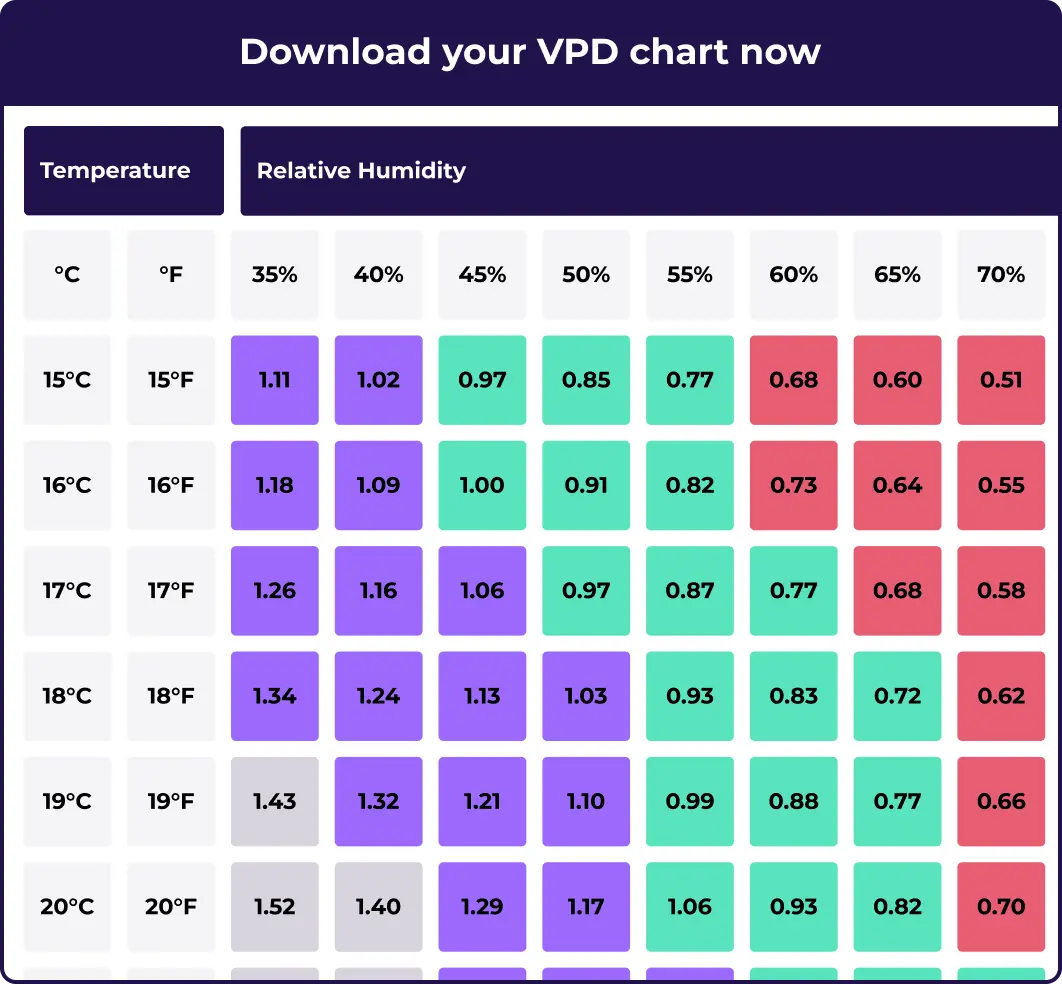
Decoding the VPD chart: A guide for cannabis growers
You can do some pretty hefty maths calculations to work out your VPD. If you’re up for the challenge, you can read about how to calculate VPD here.
To add extra complexity, VPD also differs if your plants are clones or seedlings in vegetative growth or flowering. So, most people use a VDP chart or VPD table to save time and get results faster.
A VPD chart visually represents how relative humidity and temperature interact to provide an environment for your plants. Typically, relative humidity is shown horizontally and temperature vertically.
There are 2 ways that VPD charts are presented
Separate charts for certain phases of growth
Throughout the lifetime of your plants, you’ll use different charts for propagation, vegetative growth and flowering stages.
This means you’ll need a cannabis specific VPD chart for seedlings or baby plants, a VPD chart for veg and a VPD chart for flowering.
Usually, in this sort of chart, you aim to stay within the green zone for the right VPD. The further you move away from that, the less optimal the conditions.
In these charts, sub-optimal temperatures and humidities are often represented as orange or red to show a danger zone.
These areas highlight very low or high VPD and growing conditions that are most likely to cause problems.
Charts that combine all growth phases into one chart
These grow room VPD charts use a banded approach. Different zones of the chart represent propagation, vegetative stage, and flowering.
In this sort of chart, the band to stay within for each growth stage is coloured differently. Any conditions outside those that are optimal VPD for the different stages are often coloured red, again to show the danger zone.
How to read a VPD chart
You read a VPD chart by looking at where your grow room's relative humidity intersects with your grow room's air temperature.
This shows you whether the VPD in your grow room is in the sweet spot (if it is, great job, by the way!) Or if your VPD falls on either side of that ideal range.
VPD charts show you whether you need to increase or decrease your relative humidity in combination with increasing or decreasing your temperatures to give your plants the ideal conditions for their current stage of growth.
How to use a VPD chart
- Measure the ambient room temp and humidity in your grow room air.
- Look at your VPD chart to see where your relative humidity and temperature readings intersect on the chart.
- If your readings show conditions are outside the ideal range, use the chart to determine what action to take.
- Increase or decrease your relative humidity in combination with increasing or decreasing your temperatures.
- Keep up a cycle of measuring and repeating to stay in the sweet spot.
- If your figures are within the ideal range, you're providing your plants with ideal VPD conditions - keep doing what you're doing!
So, using VPD charts shows you what optimal conditions to strive for to grow better, healthier plants, but how do you make changes to the VPD of your grow room?
The Grow VPD chart
Traditional VPD calculators and charts have limitations. They calculate vapour pressure deficit values using temperature and humidity levels.
But these aren't the only factors affecting VPD. Traditional tools miss out on considering other crucial elements.
For instance, carbon dioxide levels and light exposure significantly influence temperature. This, in turn, impacts relative humidity and VPD in your grow room.
It's a complex interaction: more light and CO2 can boost photosynthesis, affecting temperature and humidity, thus altering VPD.
Here at Grow, we’ve created The ideal VPD chart. It’s the best VPD chart and environmental timeline and is the most comprehensive solution available anywhere on the internet!
Our cannabis VPD chart and calculator generates tailored temperature, humidity, VPD, and PPFD data, and It’s the only VPD chart with CO2! It considers the interplay of these factors, making it an invaluable resource.
If you’re strapped for time, you can also take all the legwork out of measuring your grow room’s VPD by using a grow room sensor or grow room monitor like ours to measure VPD.
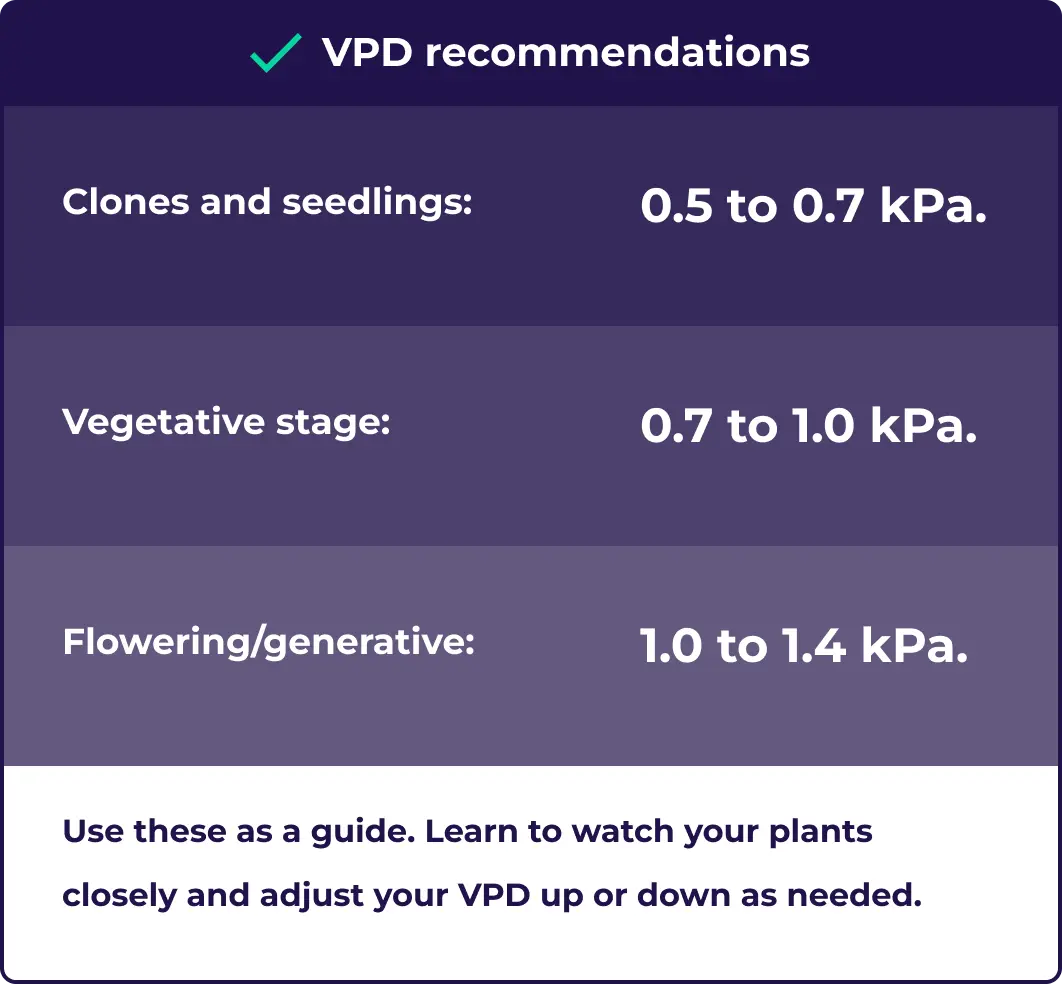
What is normal VPD?
Most plants thrive in different Vapour Pressure Deficit VPD levels throughout their growth stages, typically between 0.5 and 1.4 kPa.
Each stage of a plant's life cycle requires a specific VPD level. For example, clones need a very low VPD to develop roots; otherwise, they'll dry out.
Conversely, larger plants in later flowering do better at elevated VPD levels, which slightly stresses them and helps prevent mildew and mould.
What is a good VPD range?
A good VPD range depends on your plants’ stage of growth. Here are the ideal VPDs for different growth stages:
Clones
Since clones are young and lack fully developed roots, they require high humidity and a lower VPD, ideally between 0.5 - 0.7 kPa.

Vegetative stage
A moderate daytime VPD helps promote healthy leaf and stem growth. As cannabis plants grow bigger and stronger, you can lower the humidity slightly to increase VPD.
This enhances water and nutrient absorption. Aim for a VPD around 0.7 - 1.0 kPa, ensuring it’s not too high to avoid stomata closure and reduced CO2 absorption, which is crucial in this stage.
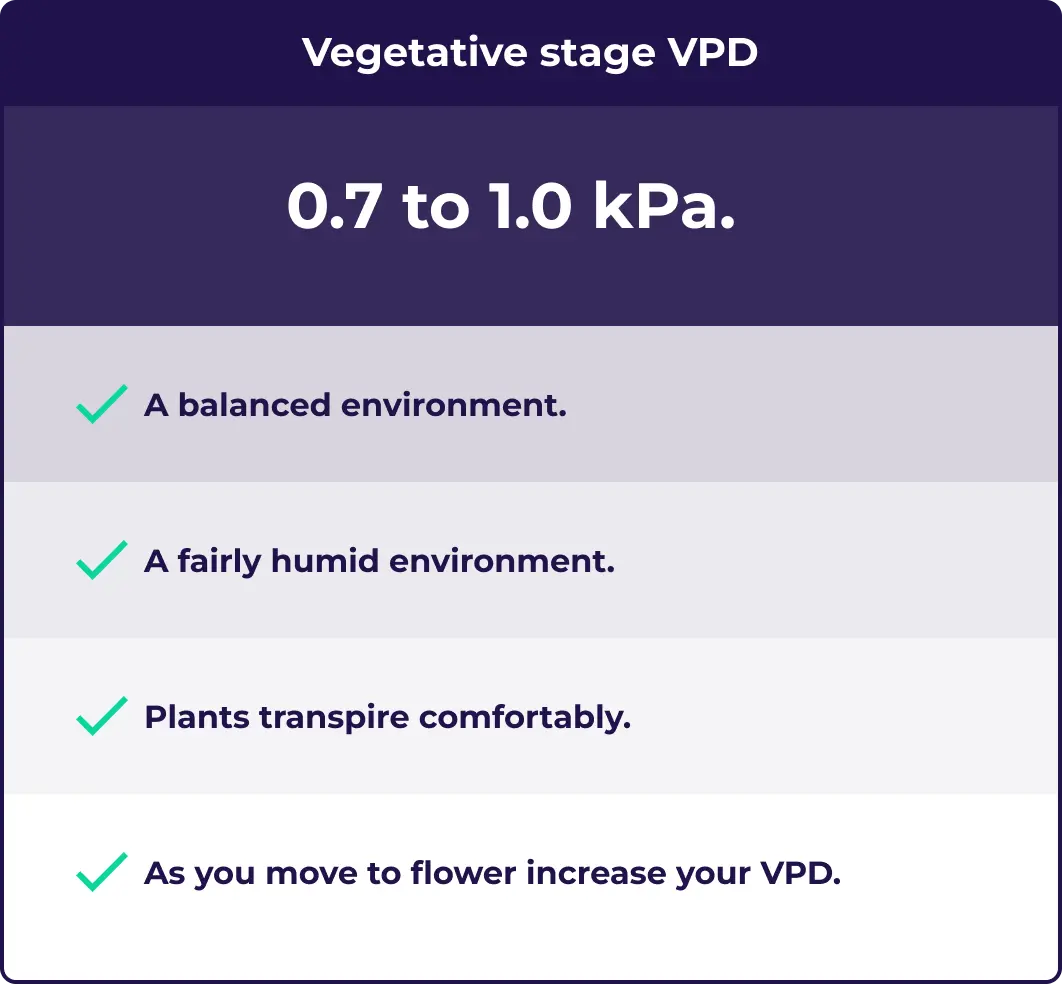
Flowering stage
In this stage, plants can handle a higher VPD. However, since flowers are sensitive, balancing VPD increases with lower humidity is important to prevent mould growth. The ideal VPD for flowering is between 1.0 - 1.4 kPa.

How using a VPD chart can help you to grow better, healthier plants
People don’t do great with extremes of temperature and relative humidity; the same goes for plants. So, let’s look at how high and low humidity scenarios affect your grow room and your plants.
Transpiration is when water evaporates from your plant's leaves via stomata (the little pores on the surface of the leaves.)

As the relative humidity in your grow space increases, your plants' ability to transpire reduces because the air becomes more saturated.
When this saturation occurs, water vapour in the air condenses into liquid, leading to dew or a thin layer of water on your plants' leaves. This creates an ideal environment for rot and mildew, which is problematic.
On the other hand, lower relative humidity in your grow room facilitates transpiration. This is due to the greater ease of water evaporation into drier air.
Additionally, any airflow from fans in your grow room leads to transpiration increases.
So, say no to too much humidity! No problem!
...Well, hold on.
At the other end of the scale, your plants are forced to pull more water from the roots in drier environments with greater vapour pressure deficit. If your plants aren’t healthy, are clones or are particularly small, they can dry out and die.
High VPD can also cause overfeeding. This is because your plants' nutrient uptake will be higher because they’re taking up all the extra water they need. Also, not good.

A happy medium is the aim of the game
This is where VPD charts come in. That band down the middle, the sweet spot, is where your plant will be fitter, happier and more productive.
Either side of that sweet spot and your plants will use its valuable resources inefficiently.
They’ll try to heat, cool, transpire, fight pests or moulds and deal with excess nutrients. They won’t be putting that energy into growth or flowering.
Whatever you’re growing, if you want the best quality, you have to provide your plants with the conditions they need to thrive.
Check out this great ‘deep dive’ interview with Nadia Sabeh from Dr Greenhouse where she talks about the effects and importance of VPD.
“Vapour pressure deficit is so critical to plant health. We can save on energy, and we can save on cost”
Creating the ideal growing environment for cannabis
Achieving the ideal vapour pressure deficit is a large part of creating a perfect growing environment for cannabis.
This involves finely tuning both humidity and temperature within your grow space. Here are some tips to help you adjust these conditions effectively:
Temperature control
Temperature is a key factor in VPD. Use heaters or air conditioners to maintain a consistent temperature that aligns with your cannabis plants' growth stages.
Typically, cannabis plants thrive at temperatures between 20-30°C during the day when lights are on and slightly cooler at night.
Humidity management
Humidity plays a significant role in VPD and transpiration rate. Seedlings and young plants benefit from higher humidity levels (around 70-80%), which can be achieved using humidifiers.
As plants enter the vegetative stage, gradually reduce humidity to about 60-70%.
Aim for lower humidity levels (around 40-50%) in flowering to prevent mould and encourage resin production.
Monitoring tools
Invest in reliable grow room sensors, hygrometers, and thermometers to monitor your grow room's conditions constantly. Some advanced systems can automatically adjust the environment to maintain the ideal VPD.
Stage-specific adjustments
The importance of environmental control varies across different cannabis growth stages. During the vegetative stage, plants are more resilient and can tolerate a wider range of VPD.
However, in the early flower stage, precise control of VPD is crucial for optimal bud development and to avoid issues like bud rot.
Air circulation
Good air circulation is essential in maintaining an even air temperature and humidity level throughout your growing space. Use oscillating fans to ensure air is evenly distributed. Circulating air cools and prevents hot or humid spots that could affect VPD.
Using these methods to carefully adjust humidity and temperature and factoring in the specific needs of each growth stage; you can create an environment that not only meets the basic requirements of your cannabis plants but also optimises their health and maximises yield potential.
This proactive approach to environmental monitoring puts some indoor growers ahead of the rest.

To increase VPD in your grow room, you can:
- Increase your ambient room temperature using heating equipment or reducing air conditioning or cooling.
- Decrease your humidity using a dehumidifier.
- Increase the intensity of your lights by moving them closer to your plants (this raises the leaf temperature.) Be sure to move your lights closer within the recommended limits provided by your manufacturer.
To decrease VPD in your grow room, you can:
- Decrease the temperature using air conditioning or another cooling method.
- Increase your humidity using a humidifier.
- Decrease the intensity of your lights by moving them further away from your plants, lowering leaf temperature. (Again, pay attention to the manufacturer's guidelines.)
The methods to adjust VPD listed above are the most common, but there are more (potentially less energy-intensive) things you can do.
For example, you could use an extraction fan to help control VPD. But air extraction and intake will affect humidity and grow room temps, which in turn can change the VPD goalposts. (It’s all part of the indoor grow Rubix cube puzzle!)
It may all sound like a lot, but knowing how to avoid potential pitfalls is half the battle! Don't worry, you’ve got this!
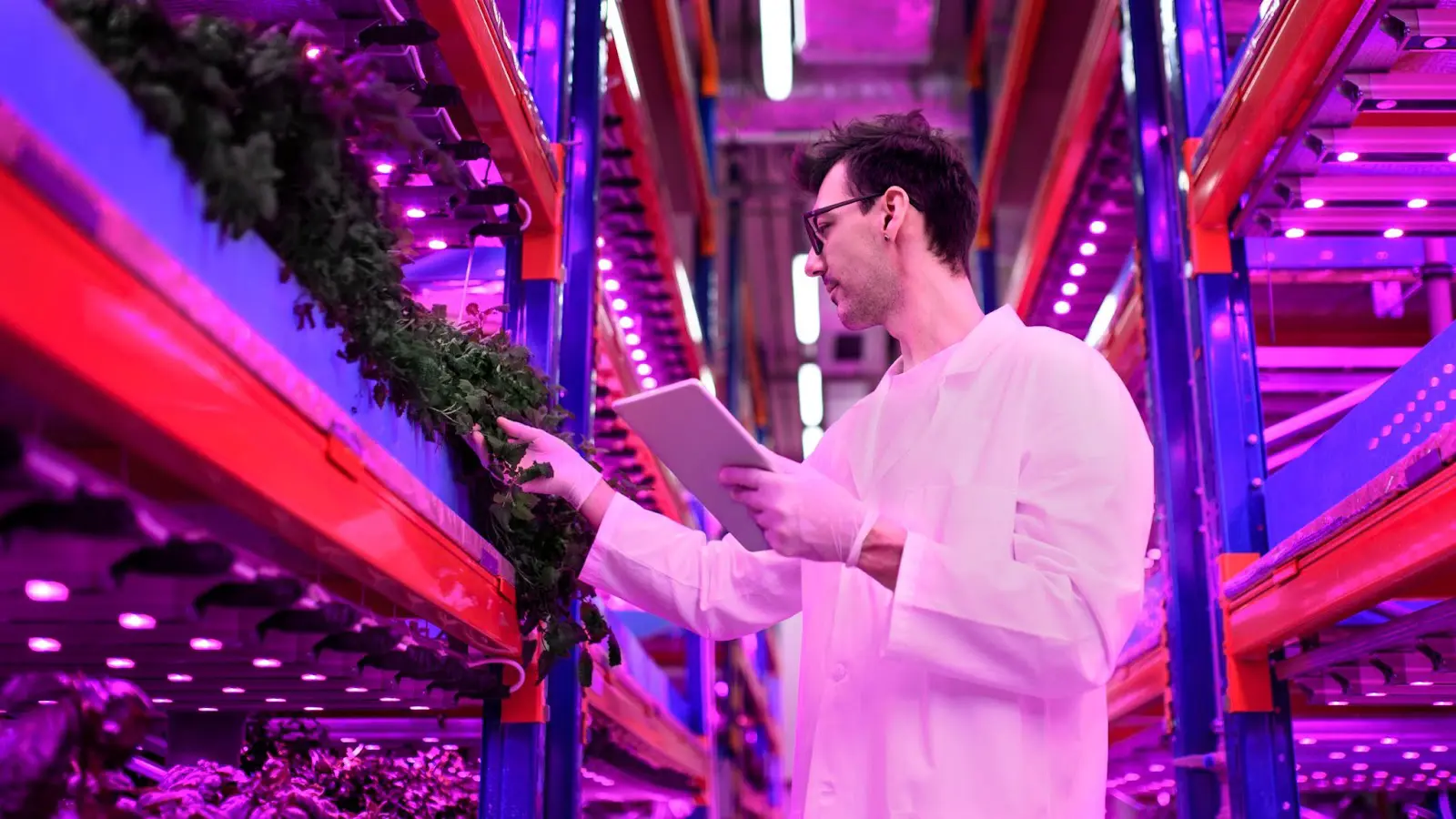
Common VPD-related challenges
Home growers often find that maintaining the ideal vapour pressure deficit (VPD) in indoor cannabis cultivation can be a complex task, often presenting several challenges.
Understanding these common issues and knowing how to troubleshoot them is key to a successful grow.
Here are some typical VPD-related challenges and strategies to overcome them:
Fluctuating humidity levels
One of the most common issues is keeping the humidity stable. Fluctuations can be caused by changes in external weather, irrigation practices, or grow room ventilation.
To combat this, use a combination of humidifiers, dehumidifiers, and proper ventilation. Regularly monitoring with hygrometers can help you respond quickly to any changes.
Inconsistent temperatures
Temperature inconsistencies can disrupt VPD balance, leading to poor plant growth. This can be due to inadequate heating/cooling systems or poor insulation.
Maintaining a consistent temperature with reliable heating and cooling systems and regularly checking thermostats can help solve this issue.
Signs of plant stress
Plants not experiencing ideal VPD may show signs of stress, such as wilting, curling leaves, or slowed growth. In such cases, promptly check your environmental controls and adjust as necessary.
Make sure you’ve placed your sensor at the right height to get an accurate reading. Read more on that here.
If plants are wilting or leaves are curling upward, it could indicate low humidity, while droplets on leaves or mould indicate elevated humidity.
Adjusting strategy for environmental fluctuations
Adjusting your strategy is essential if you notice sudden changes in your grow room’s environment.
This might involve altering your watering schedule, adjusting light intensity or changing the settings on your climate control systems.
Dealing with extremes
You might sometimes face extreme conditions like heatwaves or cold spells despite your best efforts. In such cases, being proactive is key.
Use additional cooling or heating equipment, increase air circulation, and consider shading or insulating your grow area to manage these extremes.
Remember, the key to managing VPD-related challenges is consistent monitoring and being prepared to adjust your cultivation strategy in response to environmental changes.
This proactive approach not only prevents plant stress but also ensures your cannabis plants have the ideal conditions they need for optimal growth and development.
Advanced VPD techniques for cannabis enthusiasts
For cannabis enthusiasts looking to elevate their cultivation practices, advanced techniques in manipulating vapour pressure deficit can lead to remarkable results.
By fine-tuning VPD, you can cater to specific strains or achieve desired outcomes like higher THC content or larger buds. Here are some sophisticated strategies:
Strain-specific VPD adjustment
Different cannabis strains have unique environmental preferences. Sativa strains, for instance, might thrive in a slightly raised VPD, promoting vigorous growth.
Indica strains, on the other hand, may prefer lower VPD values to enhance their dense, resinous buds. Researching and understanding the specific VPD requirements of your strain is crucial.
Manipulating VPD for desired outcomes
If the goal is to increase THC content, slightly stressing the plants in a controlled manner by increasing VPD can be effective. This should be done carefully during the flowering stage.
Maintaining a stable, slightly lower VPD during the mid-flowering (the bulking phase) can promote better bud development for larger buds. Check out our crop steering for beginners post to learn more about this.
Measure Leaf VPD
Leaf VPD (vapour pressure deficit) is intimately linked to leaf temperature, as the leaf temp significantly influences the transpiration rate and plant health.
Monitoring leaf temps with an IR thermometer provides a precise understanding of the plant’s temperature, a critical factor in managing leaf VPD.
By accurately assessing leaf temperatures, growers can adjust environmental conditions to optimise Leaf VPD, ensuring ideal moisture and temperature balance for healthy plant growth.
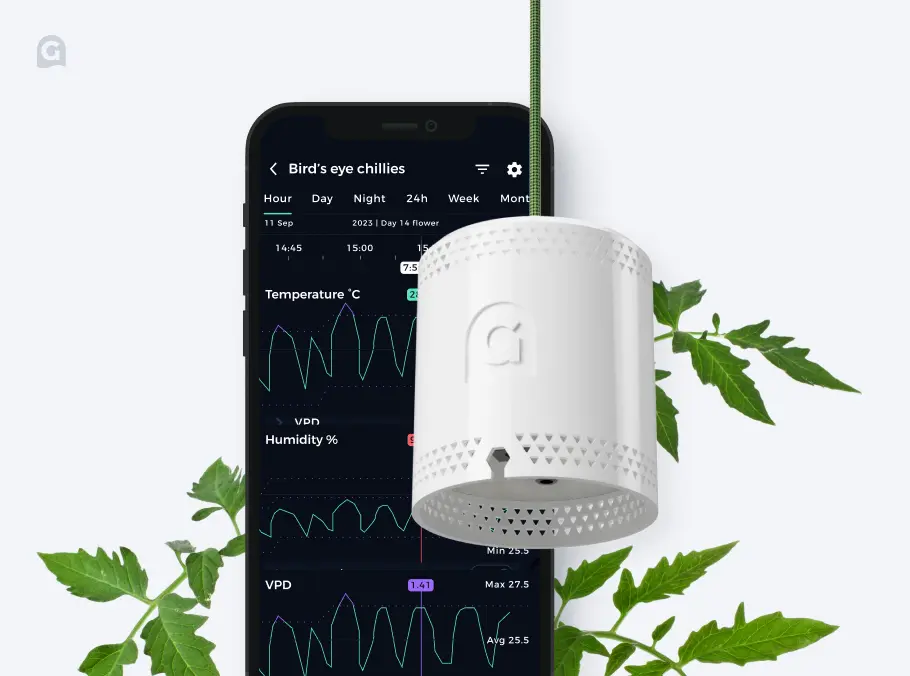
Data-Driven cultivation
Professional growers use grow room monitoring and data logging equipment like the Grow Sensor data record and analyse environmental conditions, making informed adjustments to their VPD settings.
This continuous monitoring allows for precise control and quick response to any deviation from the ideal conditions.
Utilising technology for precision
Automated systems that control temperature, humidity, and air circulation can be calibrated to maintain the perfect VPD. This technology is instrumental in large-scale operations where manual monitoring is less practical.
Collaborating with research
Some professionals collaborate with agricultural scientists or use resources from horticultural studies to understand how different VPD levels affect cannabinoid and terpene profiles. This scientific approach allows for experimentation and refinement in cultivation practices.
Mastering advanced VPD techniques involves a combination of understanding specific strain needs, purposeful environmental manipulation, and utilising technology for precision control.
This level of sophistication in VPD management allows professional cannabis growers to consistently achieve high-quality yields tailored to their specific goals.

Tools and technology for VPD monitoring and control
For effective VPD monitoring and control in indoor cannabis cultivation, selecting the right tools is key.
Beginners might opt for basic hygrometers and thermometers, which provide essential temp and humidity readings.
Tools that offer real-time data logging and remote monitoring via apps or software like the Grow Sensor are invaluable. These systems can alert you to changes in the growing environment and allow you to make precise adjustments.
The Grow Sensor hung at canopy level, is designed to measure various environmental factors, including temperature, humidity, CO2 levels, light intensity, and more, providing you with accurate, real-time data.
With its ability to measure VPD directly, the Grow Sensor helps create ideal growing conditions, which are pivotal for plant health and yield.
The sensor's advanced features, such as temperature and humidity monitoring, CO2 sensor, and full spectrum PAR sensor, are essential for detailed environmental control.
Whether you're a novice or an expert, choosing the right tools for VPD control can significantly impact the health and yield of your cannabis plants.
Takeaways
Understanding and using VPD charts is essential for successful indoor cannabis cultivation.
These charts are not just guidelines; they are tools that empower growers to create the perfect environment for their plants.
Based on these charts, you can significantly enhance plant health and yield by fine-tuning VPD settings.
I encourage all novice or expert growers to experiment with their VPD settings. This hands-on approach will deepen your understanding of plant needs and lead to more rewarding cultivation experiences. Your plants will thank you for it.
Remember, the key to mastering cannabis cultivation lies in the details, and VPD is a critical part of that puzzle.

FAQs
Is VPD more important than humidity?
VPD is often considered more crucial than humidity because it provides a more comprehensive understanding of transpiration and environmental control. VPD takes into account both room temp and humidity, offering a more complete picture for optimal plant growth.
Does VPD really matter?
Yes, VPD (vapour pressure deficit) really matters as it plays a critical role in regulating plant transpiration and overall growth conditions in a controlled environment.





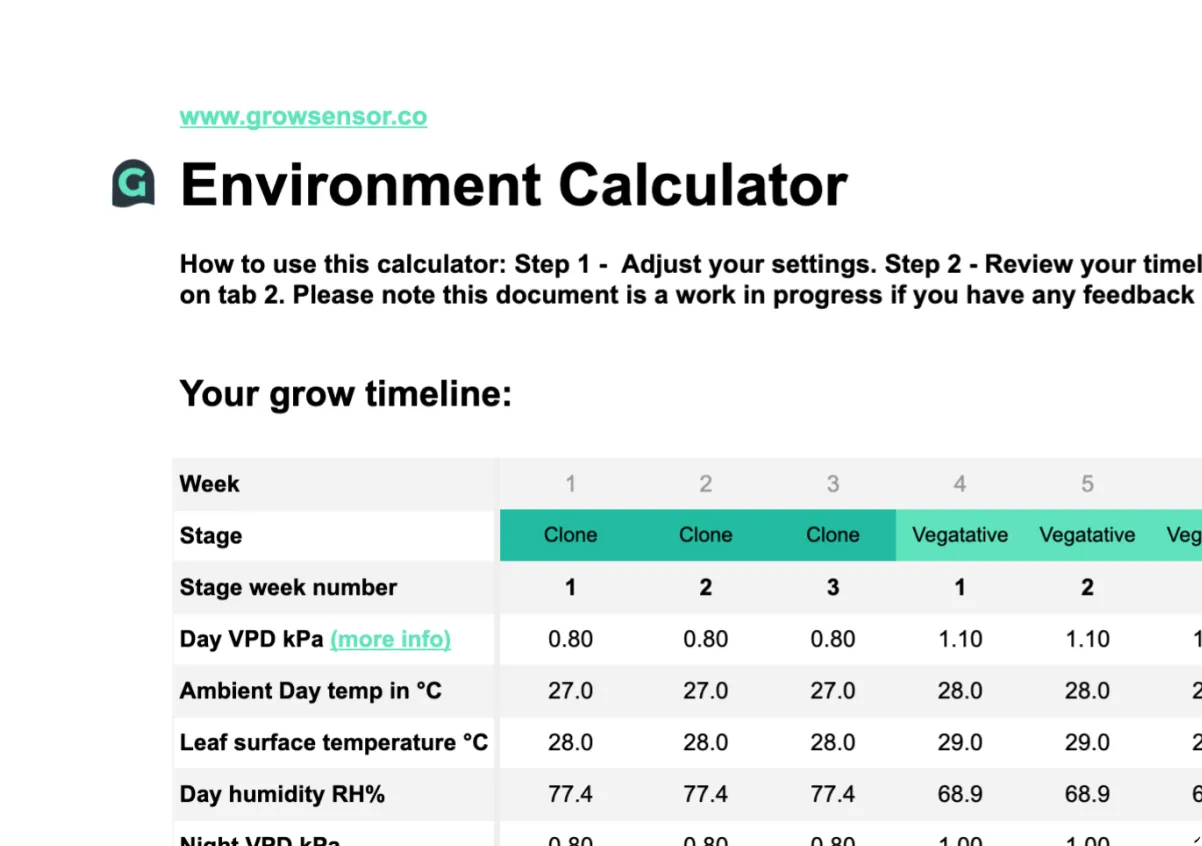



.webp)




